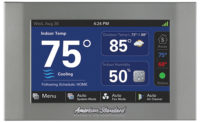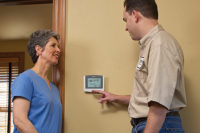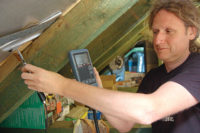The home automation market is growing globally at an incredible pace with revenue expected to hit $10 billion this year and $44 billion by 2017. The prevalence of these products can be seen with a quick trip to the hardware store, where anyone can find an array of Wi-Fi-capable home automation products, including thermostats, door locks, lights, video cameras, and more.
While some contractors are resistant to the technology, others see these products as more than just another technology to learn — they view them as an additional source of revenue, an opportunity. But home automation solutions won’t sell themselves, which is why some contractors have developed sales strategies aimed at providing the perfect solution for each of their customers.
See a Need
When selling home automation products, the most important thing a contractor can do is simply listen to the homeowner to ascertain which product features would best fit his or her lifestyle.
“Basically, it’s ‘see a need, fill a need,’” said Rich Doolittle, service manager, Norm Belval Air Conditioning and Heating Inc., Meriden, Connecticut. “If you can look around and visualize what the customer might get use and benefit from, then you can provide an answer to help fill that void. Listening to what the customer says and how they say it can also give you an idea of what they are really interested in versus what they are only mildly interested in, and then you can tie the things they really want to the so-so items and form a ‘package deal’ to satisfy multiple areas of need — both theirs and yours.”
“Listening is key,” said Dave Borowski, director of technical training, Clockwork Home Services, Naples, Florida. “We offer training to our technicians that helps them quickly diagnose what customers need and want.” He added that the contractors who are leading the market have raised the bar and offered automation-related products well before the thermostat craze took off.
Fill a Need
After listening to the customer’s needs and wants, the next step is to offer a solution — or, better yet, multiple solutions — to fit his or her lifestyle and budget.
Making a sale is about “explaining the different functions available and letting them make the decision,” said Brian McDonald, general manager, Outer Banks Heating and Cooling, Kill Devil Hills, North Carolina.
Doolittle agreed, adding that he looks “for certain features that I think my customers could really use. By demonstrating or presenting an idea of how and why that feature could be beneficial, it becomes easier to sell.”
“We’re finding most consumers’ needs are pretty straight forward,” Borowski said. “They want something that is user friendly and offers remote access and control of their home thermostat.”
However, Borowski warned about offering products that are too far beyond what the homeowner has indicated he or she needs. “While very sophisticated and complex tools are available, for the most part, they cause ‘analysis paralysis’ and are more appropriate for critical applications like health care,” he said.
Parting Advice
McDonald said Outer Banks offers smart products on every job, and he suggests other contractors do the same. “If you don’t offer them, they can’t buy them from you,” he pointed out.
Doolittle suggested starting small and working up from there. “Start with upgrading thermostats,” he said. “Start with monitoring, like getting them interested in alerts when certain items or equipment fail or don’t perform as desired, then, from there, they will be interested in being able to make changes from afar. Then, they will be interested in interacting with things at their property, like lights and/or remote access for visitors, and then from that point seeing who is there and what they may be doing. It all starts with the customer having a need to do something, and then it will grow from there.”
Finally, Borowski said contractors need to “do more than due diligence before jumping into this arena to see if all your needs can be met.” Contractors who are new to selling home automation products should find one brand and stay with it, which will make things simpler.
“It seems every day a new innovation is introduced with an even lower cost… so, in all likelihood, the best products are truly around the corner,” he added.
Publication date: 8/25/2014
Want more HVAC industry news and information? Join The NEWS on Facebook, Twitter, and LinkedIn today!







Report Abusive Comment